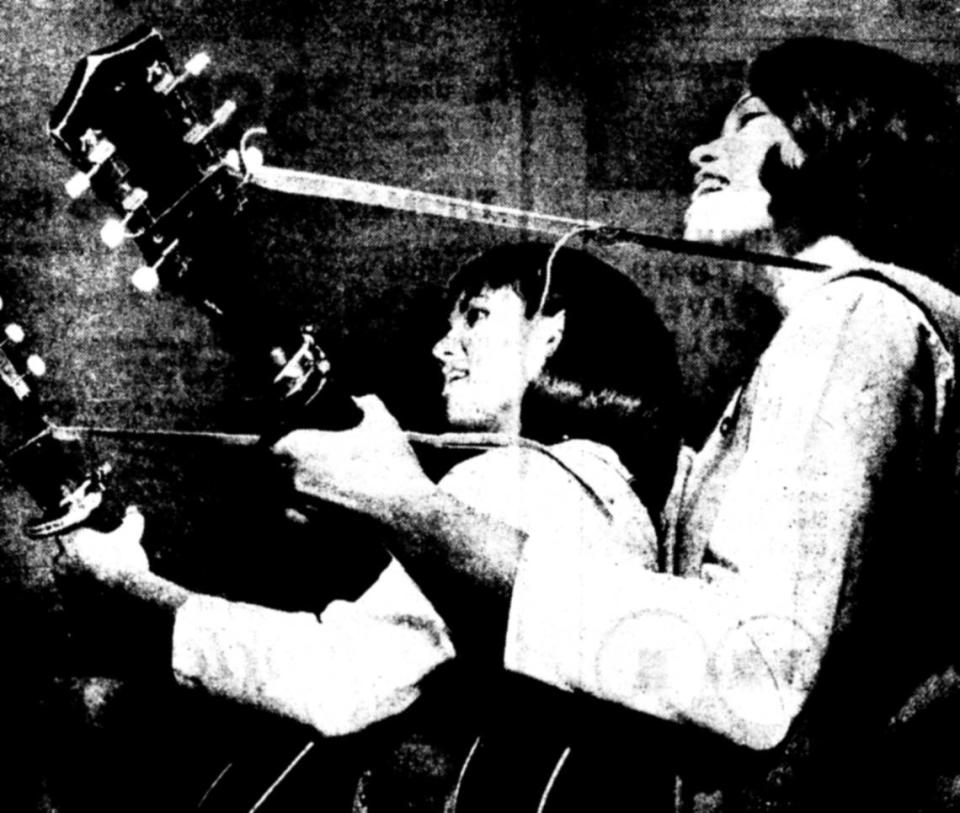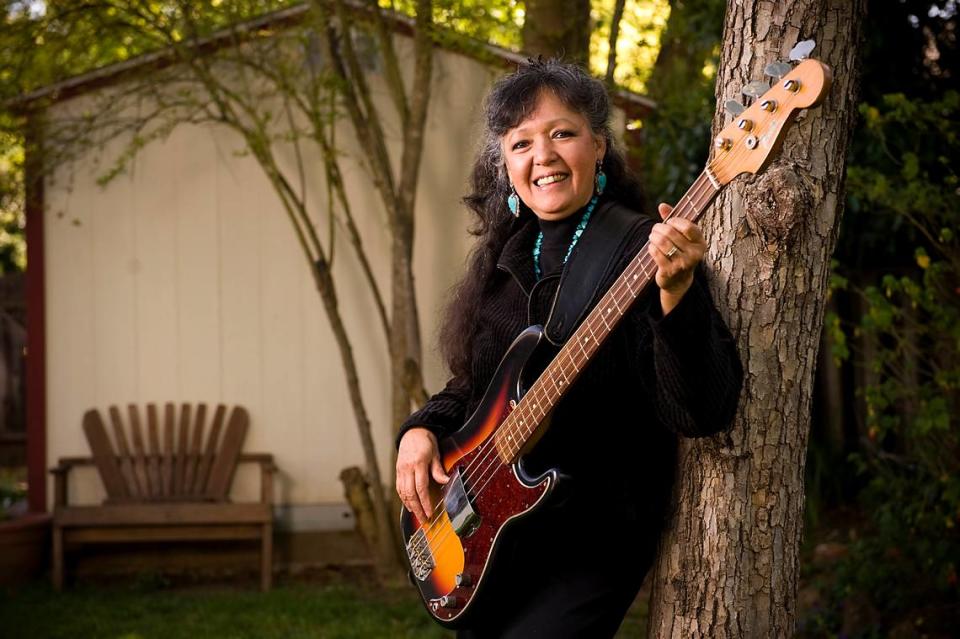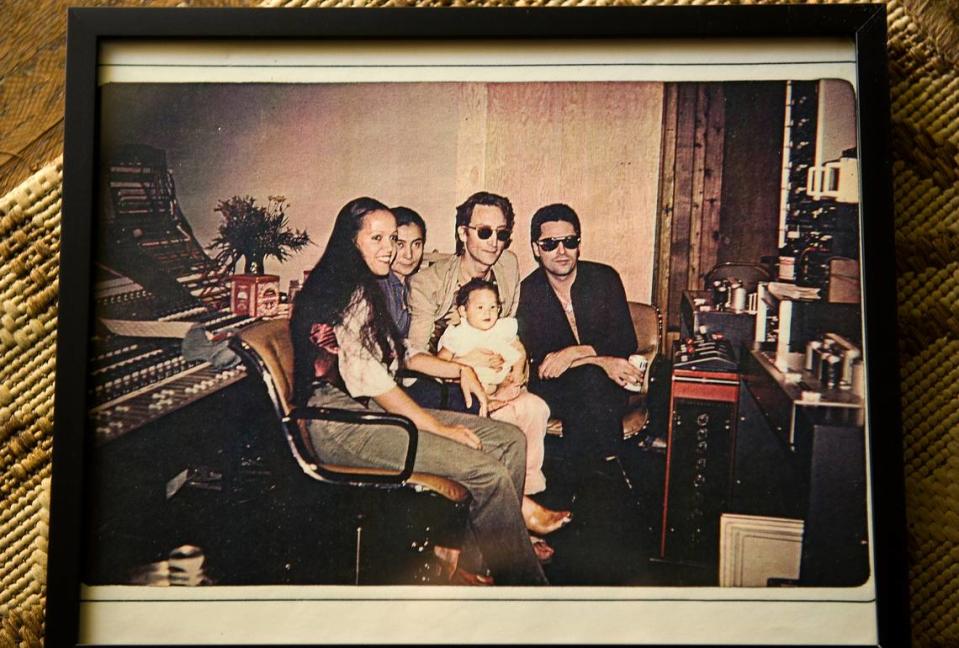How three Sacramento-area women, featured in recent documentary, became rockstars
- Oops!Something went wrong.Please try again later.
- Oops!Something went wrong.Please try again later.
June Millington still remembers the song she performed that changed her life.
Millington, 75, played lead guitar for Fanny, one of the first all-female rock bands. While the group split in 1975, it’s had a resurgence in popularity in recent years, thanks in part to a 2021 documentary, “Fanny: Rocked the Earth” that screens Dec. 6 at the Crest Theatre. Vintage YouTube clips of the band have also racked up millions of views.
Long before all of this, though, in the early 1960s, Millington and her sister, now known as Jean Adamian, had just moved from the Philippines to Sacramento and were students at what was then known as California Junior High. With two other girls, the sisters performed an original song, “Miss Wallflower of ’62” at a variety show on March 15, 1962.
Kids began to stop them in the halls thereafter.
“All of a sudden, we were recognized and people were saying something to us,” said Millington, who now lives in Massachusetts. “So that changed our lives and it totally set our trajectory.”
The story of the band Fanny is one about a group of talented musicians who’ve been rediscovered and finally given due late in life that eluded them earlier due to factors beyond their control like sexism and misogyny. Another side of their story that might not be as known: How much Sacramento played a role in the band’s rise.
Playing on the ship
Millington’s and Adamian’s mother, whose birth name was Yolanda Limjoco, was Filipina. Their father, Jack Millington, met Limjoco while he was serving in the United States Navy. The sisters were born in their mother’s native country.
In the Philippines, the sisters began to teach themselves how to play music, initially on ukuleles. Sometimes they asked boys in the neighborhood how to play songs. Other times, they just listened to the radio and figured out how to play what they heard, preferring artists like Neil Sedaka, Harry Belafonte and the Everly Brothers.
In 1961, the family moved to the United States. Jack Millington left the Philippines ahead of his wife and children so he could travel the U.S. in search of a place for them to settle.
“He was looking for the good place to raise his family,” said Adamian, who is now 74 and lives in Davis. “He chose Sacramento.”
The rest of the family followed on a ship, with the journey taking a month. Millington still has a photo of her and her sister performing on the ship, in a meal hall. Millington suspects that some of the ship’s officers must have seen her and Adamian singing.
“We would just sit down and enjoy ourselves singing all the time,” Millington said. “They must have heard us and thought, ‘Oh God, they’re good.’”
The family moved to a house on Portola Way in Curtis Park. Their real estate agent encouraged her daughter, the former Shelley McClanahan, to meet the sisters. McClanahan brought along a friend, Judy Simons.
“We went over and we had a lovely time and they started singing,” Simons said. “I said, ‘Oh, you guys, you sing so well.’”
The girls started singing together, calling themselves The Four J’s and soon debuting “Miss Wallflower of ’62.” Simons, who would later move to New York City and become a flight attendant, still remembers some of the lyrics, singing during an interview with The Sacramento Bee:
Here I am by the wall again
Waiting for (this) dance
But no one wants to ask me
Oh, I’m lonely for romance
The response to the song helped change what was in some ways a rough start for the Millington sisters’ life in Sacramento.
“We were kind of three or four years behind the times, so it was very difficult fitting in,” Adamian said.
Race could have factored into their struggles, too.
“All things considered, it was a really good place to grow up,” Adamian said. “But… as far as people were concerned, we were Filipino.”
Better days were ahead.
Getting to Fanny
The sisters soon broke with Simons and McClanahan, opting instead to perform hootenanny and folk music as a duo. They got support from a sewing circle of the YWCA, whose members went so far as to book gigs for the girls.
“One of them, I remember, was in a mental institution, but we did get paid like ten bucks or something – enough to buy strings,” Millington said.
Around this time, Adamian had a boyfriend who played in a surf band. The sisters would bring acoustic guitars to their shows, on which they could play popular songs like “Nowhere to Run” by Martha and the Vandellas. Together with two other girls, drummer Kathy Terry and guitarist Cathy Carter, they formed a new band in late 1964 called The Svelts.

“What we would do, we would play when they were on their break,” Adamian said. “That’s how we first started getting gigs.”
The girls soon procured electric equipment. Millington eventually learned how to read music when she went to college. Adamian never learned, remembering the painstaking effort by which she figured out how to play bass.
“June would play an A chord on a guitar,” Adamian said. “I would push around on the bass ’til the note was right… We just did it by ear, literally by ear.”

Another local Filipina-American girl, born Marie Berry but known professionally as Brie Darling, took over for Terry on drums around 1965. Darling became fast friends with Adamian, who’d pick her up from her home in Folsom and bring her to Portola Way for weekend sleepovers to rehearse with the band.
“We were kind of the ones who were laughing and having a good time while June’s writing down the lyrics that I’m supposed to be learning,” said Darling, who is now 74 and lives in Portland, Oregon.
Tamara Reynolds grew up on Portola Way, sometimes riding roller skates and hanging out near where the band’s practices took place. “Sometimes they’d play a full song or something,” Reynolds said. “And then the rest of the time, they were just doing all kinds of other stuff.”
The Svelts were strictly a cover band with a penchant for playing Motown songs, which would follow them to Fanny. In a YouTube clip from the early 1970s, Fanny plays a cover of Marvin Gaye’s classic “Ain’t That Peculiar,” with Millington playing a mean slide guitar.
Even as the Svelts, the girls attracted some notice. The Sacramento Bee noted in 1966 that the group would be playing at the state fair, along with bands like New Breed, whose member Timothy B. Schmit would later join the Eagles.
During these years, the Millington sisters attended McClatchy High School, where they played music in other capacities, too. The school yearbook for 1965 shows a picture of the two playing at a California Scholarship Federation event.
Musically, their efforts continued to evolve, even after they left Sacramento. Their professional break came in 1969 when they moved to Los Angeles, signed a music deal with Warner Brothers and became Fanny.
Fanny’s reign and resurgence
Officially, Fanny existed for about six years, breaking up in 1975 shortly before achieving their only Top 40 hit, “Butter Boy.”
Darling was fired from Fanny shortly after moving to LA, as the band had two drummers. She returned near the end of Fanny’s run and has had a long career as a songwriter and session musician, working with everyone from Carole King to Michael Jackson.
Otherwise, Fanny’s primary quartet was the Millington sisters, drummer Alice de Buhr and keyboardist Nickey Barclay.
Members of the band lived in a rented mansion that they called Fanny Hill that had formerly been owned by actress Hedy Lamarr. Visitors to the mansion included musician Joe Cocker.
There were other brushes with history for the women as well. A few months after moving to LA, Millington was practicing guitar late one night when she heard what sounded like gunshots. The next morning, she learned of the murders of Sharon Tate and several other people by followers of Charles Manson. Millington said she lived the next canyon over.
Fanny recorded five albums, becoming the first all-female rock group to release an album on a major label, according to a 2018 Rolling Stone retrospective. But the women never broke through to major stardom during the band’s initial run. Asked why this was, Millington didn’t hold back, citing “flat-out prejudice and misogyny.”
Still, this wasn’t the end of Fanny’s story.
Fans of Fanny included legends like David Bowie, who told Rolling Stone in 1999, “They were just colossal and wonderful, and nobody’s ever mentioned them.” Another famous fan is Bonnie Raitt, who sits on the board of a program Millington founded in 1986, the Institute for Musical Arts which supports female musicians.

Fanny’s fade into obscurity began to change in the early 2000s, with the release of a four-CD retrospective. Millington listened to some of her old recordings during production for this set. “My partner was in the room and I turned to her and said, ‘You know, I always wanted to play like that. I just didn’t know I did,’” Millington said.
Adamian’s found new appreciation for Fanny over the years.
“Listening to us, I discovered how good a band we actually were,” Adamian said.
Millington, Adamian and Darling reunited to record a 2018 album as a spinoff band, Fanny Walked the Earth. The documentary debuted three years later.
On May 22, the documentary screened at the Crest Theatre, the same night it aired locally on KVIE. Fanny also played live for more than an hour. Adamian, who hasn’t regained the ability to play bass since suffering a stroke in recent years, joined the band on-stage to sing.
Fanny played to a packed house, some of whom remembered the women from their Sacramento days. “There were standing ovations, people were dancing in their seats, up clapping, cheering,” said Steve Sweeney, who does fundraising and events supervision for KVIE. “It was a really vibrant night.”
Attendees included members of Girls Rock Sacramento, an organization Darling has assisted. That group’s founder Larisa Bryski is familiar with the sort of discrimination Fanny faced, because she still sees it for women in the industry today.
“In a lot of situations, having a girl play rock music is still considered like cute or sort of a token thing,” Bryski said.
Another person at the Crest that night, 98 Rock on-air personality and Girls Rock Sacramento board member Myki Angeline is hopeful about what younger generations will be able to do for inclusivity. And she’s thankful for the pioneering work of Fanny and that the women have continued to make music over the years.
“I think it really is – I overuse the word empowering – but really inspirational that they never gave up and they kept pushing through,” Angline said.
She added, “I love that they aren’t a thing of the past, they’re part of the present and even the future.”

